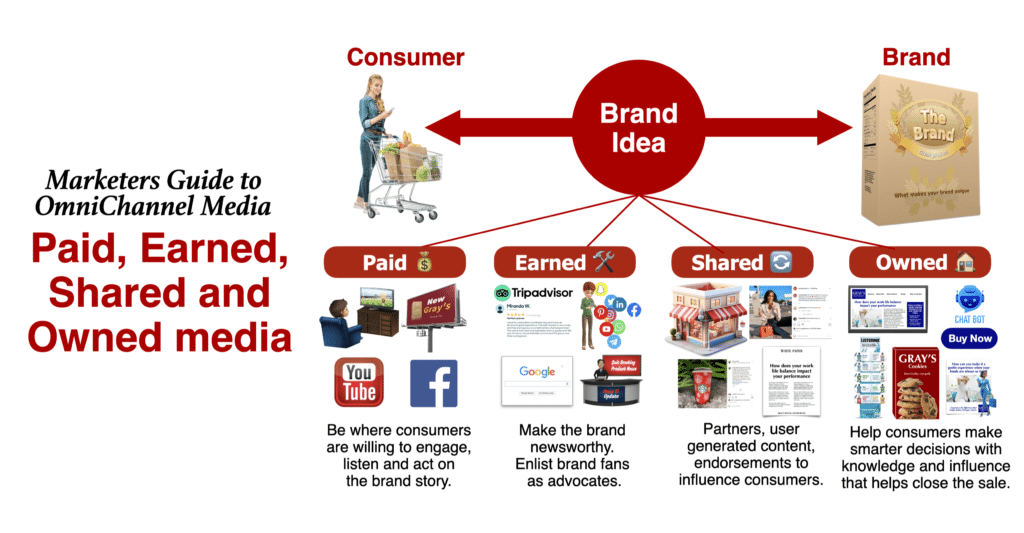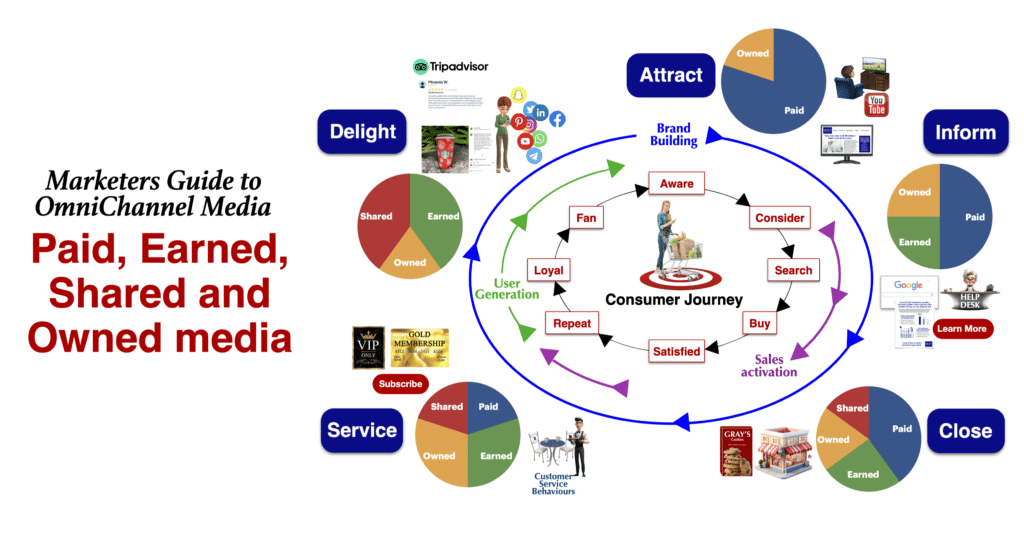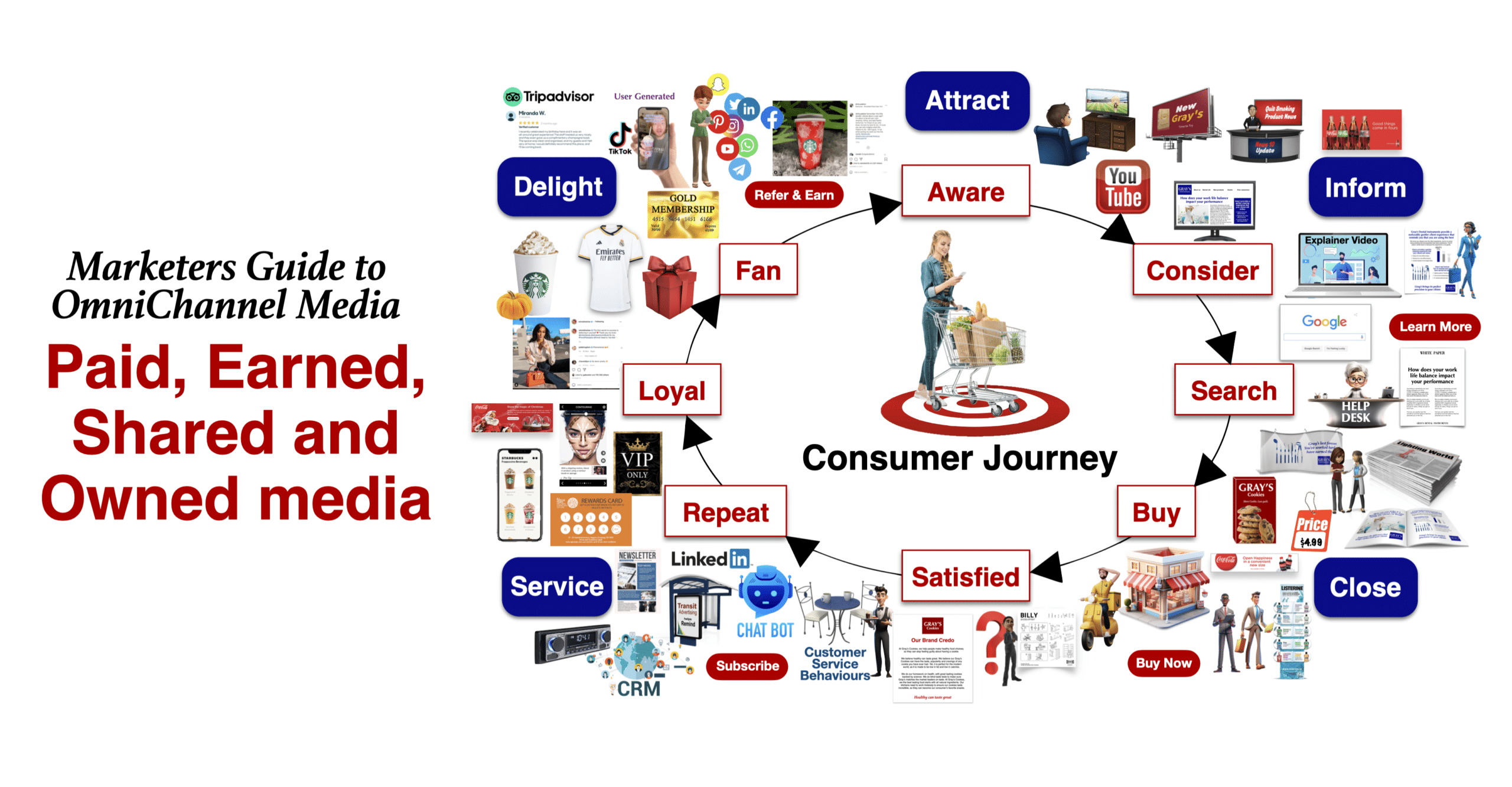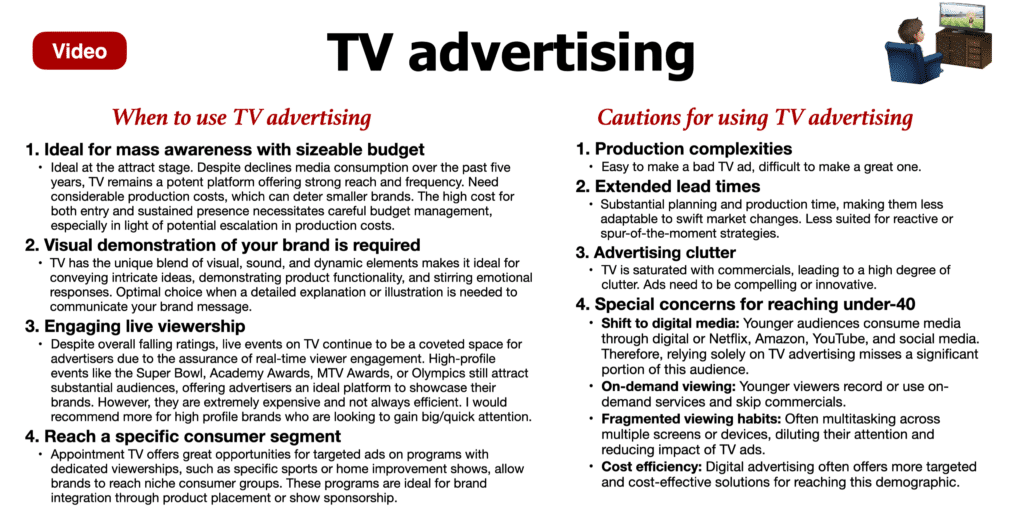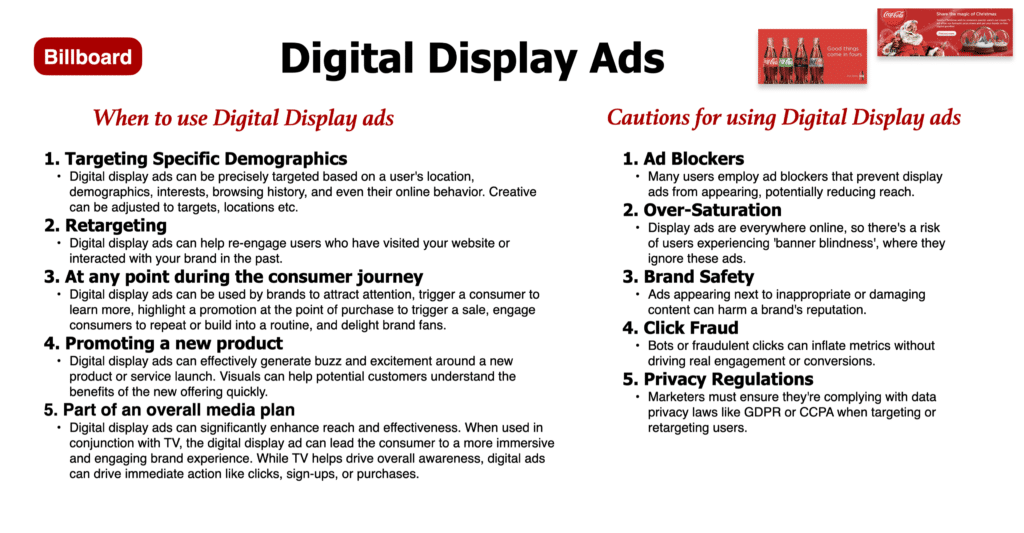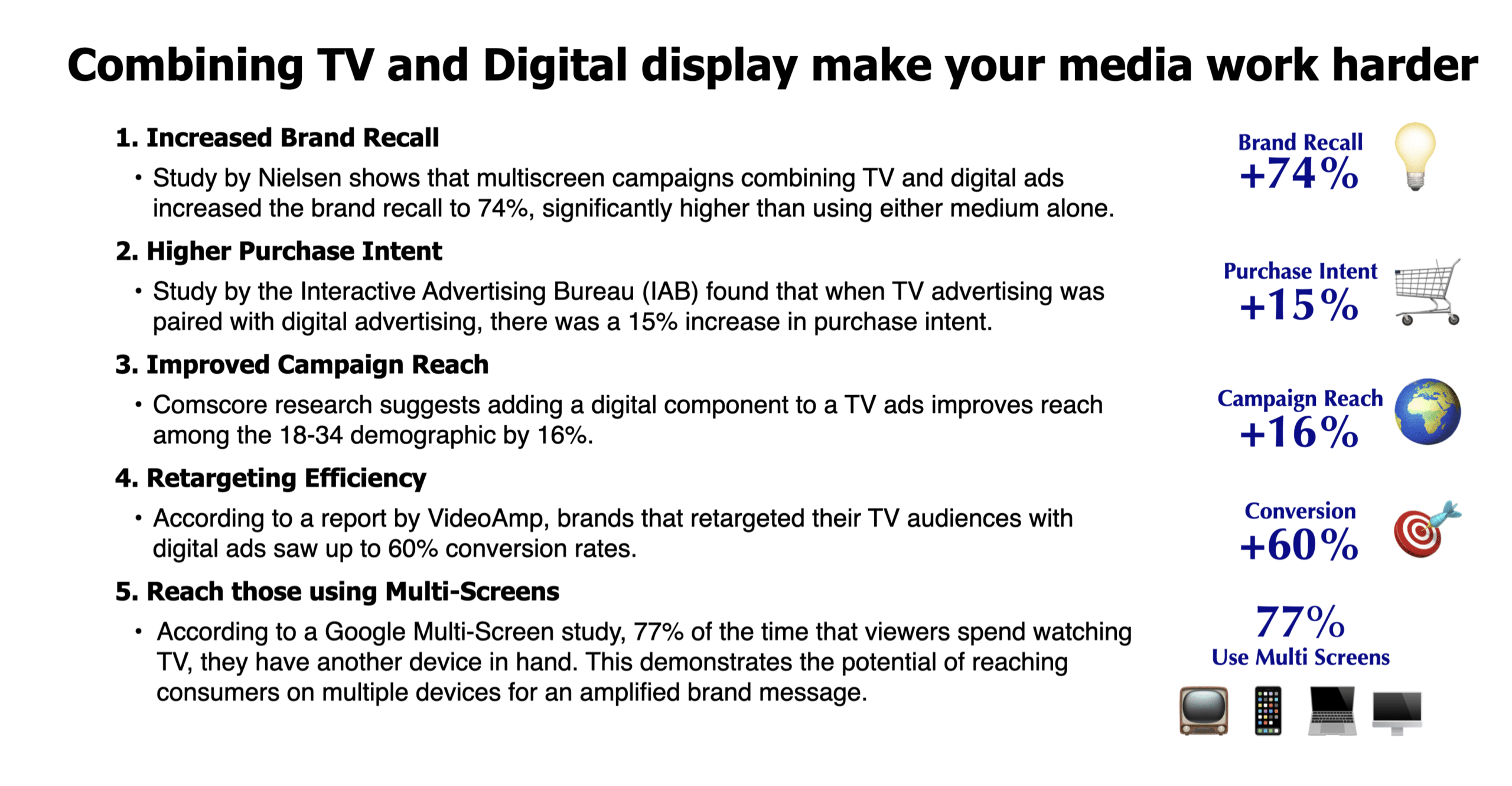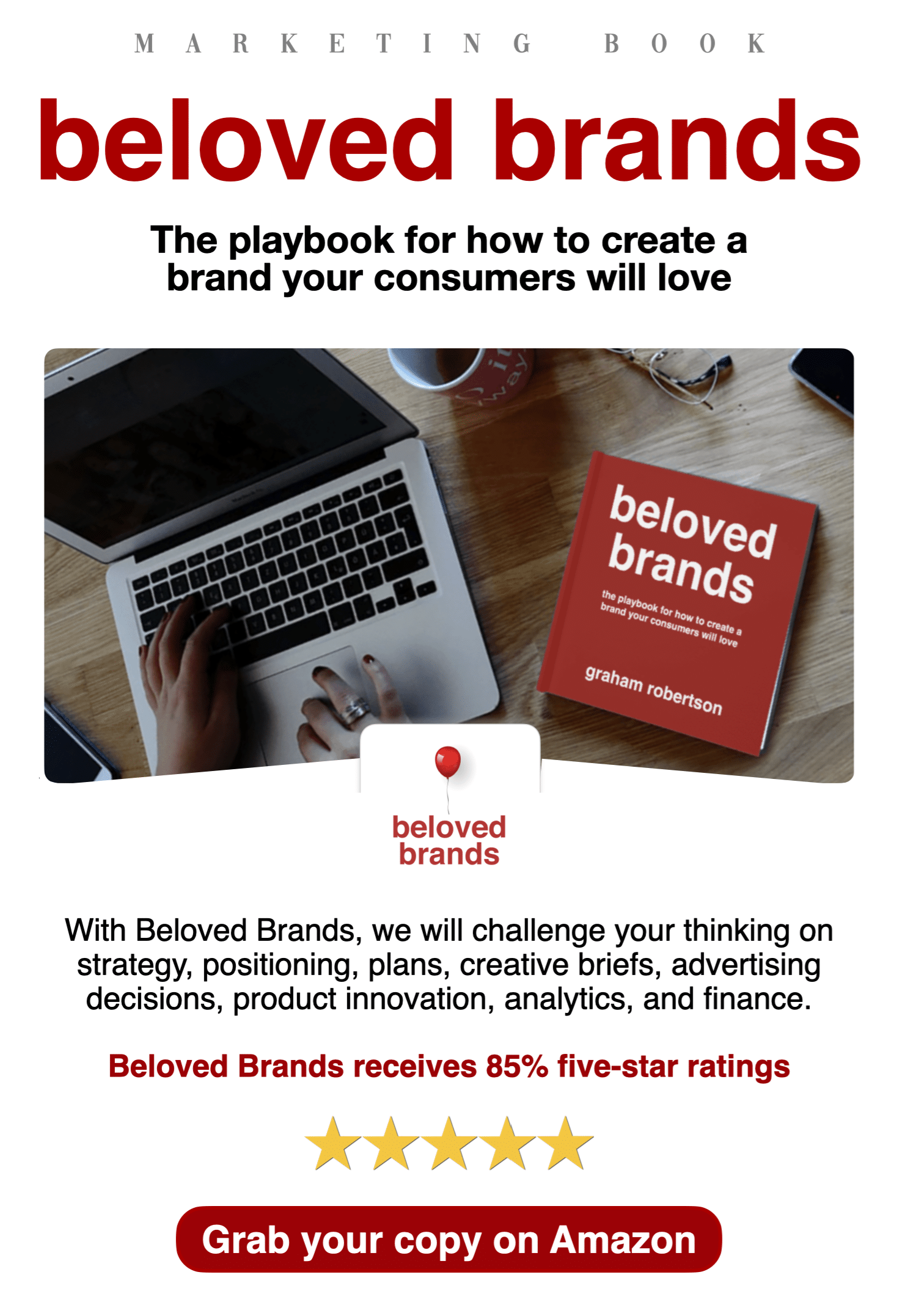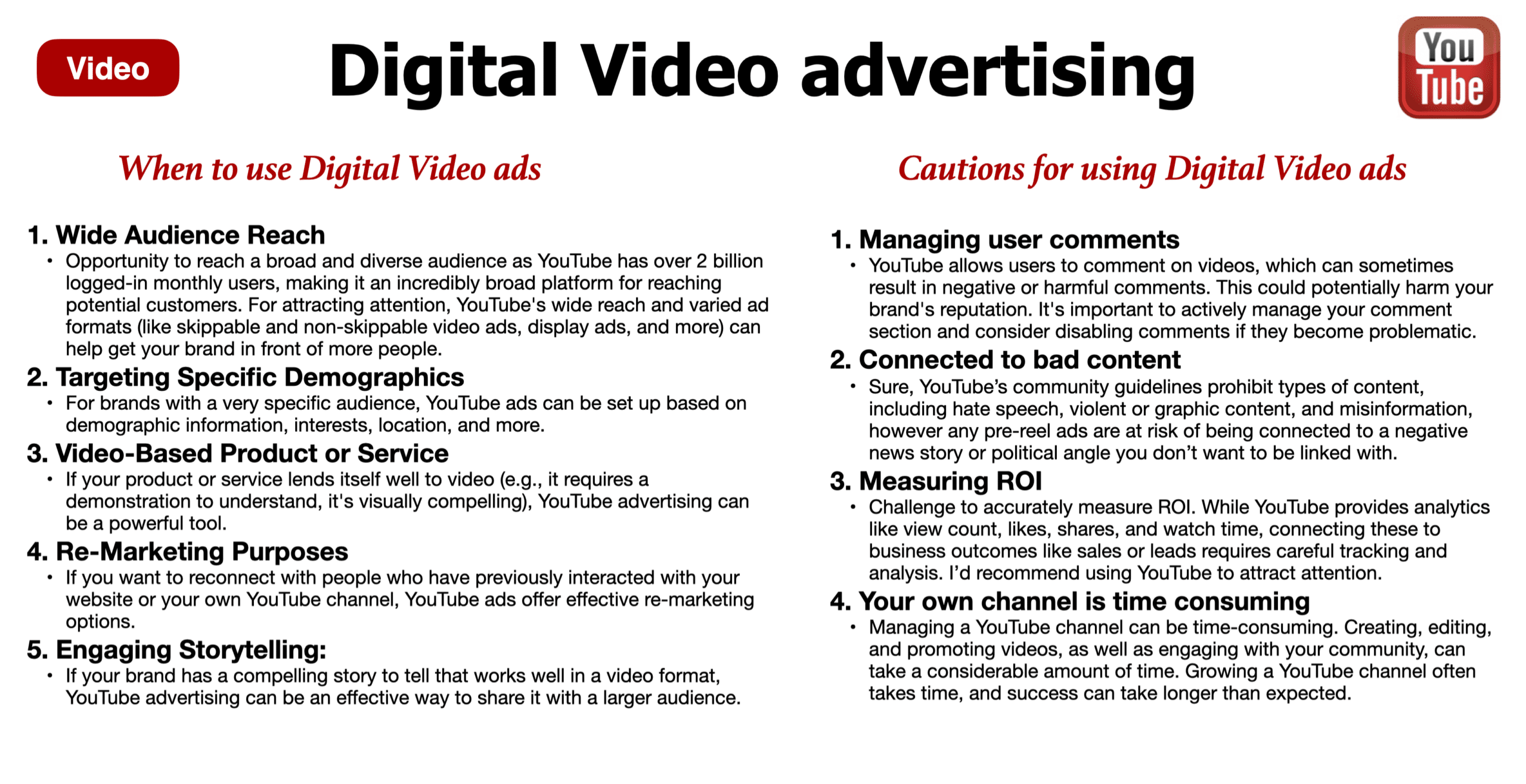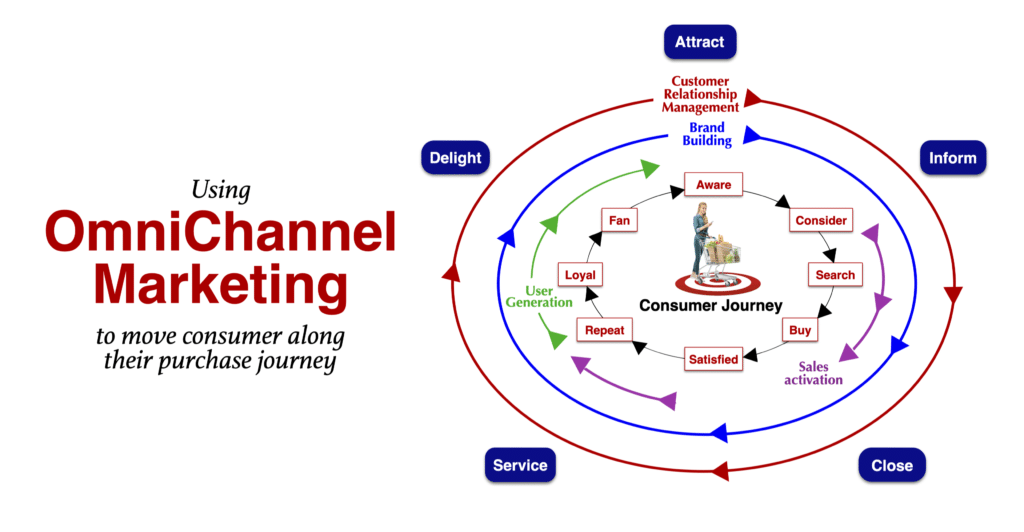In today’s fragmented digital landscape, a robust brand strategy is not just about being visible, it’s about being omnipresent. For brand leaders and top-tier marketing professionals, the strategy has shifted from a Multi-Channel media approach to an OmniChannel Media strategy. This intricate ballet of Paid, Earned, Shared, and Owned (The PESO Model™) media is where brand success lies.
To illustrate, click on the OmniChannel Media diagram to zoom in and see details.
Paid, Earned, Shared, Owned media
Closer look at this dynamic PESO quartet and how it can be used to manage the consumer journey.
Paid Media:
Think of this as the frontline of your brand’s offensive strategy. This is where you’re pushing the message out, announcing your brand’s presence. Paid media platforms such as traditional media including TV advertising, out-of-home, and print. Or it includes digital display banners, online video ads, and sponsored content provide the initial broad reach, ensuring a massive audience gets acquainted with your brand.
Earned Media:
The endorsements your brand earns organically. When consumers talk about your product, when an influencer shares their experience, or when you’re mentioned in a media story – this is where the brand’s credibility amplifies. In many ways, earned media is the modern word-of-mouth, bolstered by technology and reach.Public relations, influencers, and social media. Or, it could be as simple as the lunch table at work or the backyard BBQ.
Shared Media:
The junction where brands and consumers meet. Platforms like Instagram or Twitter, where consumers can converse with brands or share their experiences, fall here. These spaces offer invaluable insights into consumer sentiment and provide a platform for real-time engagement. You can also look at shared media with a partner whether with another brand, an event, or a retail partner.
Owned Media:
The brand’s fortress. Whether it’s your own packaging, in-store display material, your website, social media pages, or newsletters, these are the channels you have full control over. Here, messaging is consistent, and the brand’s narrative is curated meticulously.
How Paid, Earned, Shared, and Owned media match up to the consumer journey.
To illustrate, click on the OmniChannel Marketing diagram to zoom in and see details.
Attract:
As a brand, your first impression matters. Distinguish your brand with stellar creatives that make you stand out amidst a cluttered marketplace. Invest in high-impact paid media channels, ensuring potential consumers stop and take notice. For those who wish to dive deeper, make sure your owned platforms, particularly your website, are primed to provide rich information.
Inform:
Here, the narrative deepens. Harness the power of earned media to create organic buzz. Complement this with detailed insights on your owned platforms, clearing doubts and laying down the path to purchase.
Close:
Gaining the trust of a consumer is paramount. A holistic strategy weaves shared media into the mix. Collaboration with retailers, e-commerce testimonials, and influential in-store sales personnel can be the difference between a near-miss and a confirmed sale.
Service:
Post-purchase is where brand loyalty is cemented. Offer top-notch service, be it through dedicated customer service representatives or efficient self-help systems on owned platforms. Creating memorable post-purchase experiences can lead to repeat business and lifelong brand advocates.
Delight:
This is the crescendo. Engage deeply with your most enthusiastic customers. Host events, create share-worthy content, and foster a community around your brand. When these brand enthusiasts share their stories, it creates a ripple effect, influencing new prospects and fortifying your brand’s standing.
In a separate article, we go through OmniChannel Marketing options at each stage of the consumer journey. Click on this link to read more: OmniChannel Marketing
There are so many media choices. Make sure you choose the right one to move consumers along their journey.
Take a look at our fmedia chart below. While it looks a bit cluttered, it shows how many choices there are in an OmniChannel Media world that can help you deliver at each stage of the consumer journey.
To Illustrate, click on the OmniChannel Media diagram to see all the paid, earned, shared and owned media.
Marketers Guide to OmniChannel Media
To illustrate, we go through 14 different media choices with when to use and what cautions to be aware of:
📺 𝗧𝗵𝗲 𝗖𝗹𝗮𝘀𝘀𝗶𝗰𝘀: Starting off with the timeless titans – TV, Out-of-Home, and Print. Why are they still relevant, and when should you lean on them?
🌐 𝗗𝗶𝗴𝗶𝘁𝗮𝗹 𝗗𝗶𝘃𝗲: From Digital Display to the mesmerizing realm of Digital Video and harnessing the power of your own video content. The digital domain awaits!
📲 𝗦𝗼𝗰𝗶𝗮𝗹 & 𝗕𝗲𝘆𝗼𝗻𝗱: Navigating the bustling streets of social media, leveraging user-generated content, and mastering the art of PR. We’ve got the roadmap!
💻 𝗖𝗿𝗲𝗮𝘁𝗶𝗻𝗴 𝗬𝗼𝘂𝗿 𝗢𝗻𝗹𝗶𝗻𝗲 : Ever contemplated when it’s prime time to establish your own website? How about acing content marketing or optimizing for SEO? We’ve got the answers!
To illustrate, click X to expand the document and then the > to view each page.
TV advertising
When to use TV
1. Ideal for mass awareness with sizeable budget
Ideal at the attract stage. Despite declines media consumption over the past five years, TV remains a potent platform offering strong reach and frequency. Need considerable production costs, which can deter smaller brands. The high cost for both entry and sustained presence necessitates careful budget management, especially in light of potential escalation in production costs.
2. Visual demonstration of your brand is required
TV has the unique blend of visual, sound, and dynamic elements makes it ideal for conveying intricate ideas, demonstrating product functionality, and stirring emotional responses. Optimal choice when a detailed explanation or illustration is needed to communicate your brand message.
3. Engaging live viewership
Despite overall falling ratings, live events on TV continue to be a coveted space for advertisers due to the assurance of real-time viewer engagement. High-profile events like the Super Bowl, Academy Awards, MTV Awards, or Olympics still attract substantial audiences, offering advertisers an ideal platform to showcase their brands. However, they are extremely expensive and not always efficient. I would recommend more for high profile brands who are looking to gain big/quick attention.
4. Reach a specific consumer segment
Appointment TV offers great opportunities for targeted ads on programs with dedicated viewerships, such as specific sports or home improvement shows, allow brands to reach niche consumer groups. These programs are ideal for brand integration through product placement or show sponsorship.
Cautions for using TV
1. Production complexities
Easy to make a bad TV ad, difficult to make a great one.
2. Extended lead times
Substantial planning and production time, making them less adaptable to swift market changes. Less suited for reactive or spur-of-the-moment strategies.
3. Advertising clutter
TV is saturated with commercials, leading to a high degree of clutter. Ads need to be compelling or innovative.
4. Special concerns for reaching under-40
- Shift to digital media: Younger audiences consume media through digital or Netflix, Amazon, YouTube, and social media. Therefore, relying solely on TV advertising misses a significant portion of this audience.
- On-demand viewing: Younger viewers record or use on-demand services and skip commercials.
- Fragmented viewing habits: Often multitasking across multiple screens or devices, diluting their attention and reducing impact of TV ads.
- Cost efficiency: Digital advertising often offers more targeted and cost-effective solutions for reaching this demographic.
To Illustrate, click on the OmniChannel Media diagram to read about paid, earned, shared and owned media.
Digital Display Ads
When to use Digital Display
1. Targeting Specific Demographics
Digital display ads can be precisely targeted based on a user’s location, demographics, interests, browsing history, and even their online behavior. Creative can be adjusted to targets, locations etc.
2. Retargeting
Digital display ads can help re-engage users who have visited your website or interacted with your brand in the past.
3. At any point during the consumer journey
Digital display ads can be used by brands to attract attention, trigger a consumer to learn more, highlight a promotion at the point of purchase to trigger a sale, engage consumers to repeat or build into a routine, and delight brand fans.
4. Promoting a new product
Digital display ads can effectively generate buzz and excitement around a new product or service launch. Visuals can help potential customers understand the benefits of the new offering quickly.
5. Part of an overall media plan
Digital display ads can significantly enhance reach and effectiveness. When used in conjunction with TV, the digital display ad can lead the consumer to a more immersive and engaging brand experience. While TV helps drive overall awareness, digital ads can drive immediate action like clicks, sign-ups, or purchases.
Cautions for Digital Display Ads
1. Ad Blockers
Many users employ ad blockers that prevent display ads from appearing, potentially reducing reach.
2. Over-Saturation
Display ads are everywhere online, so there’s a risk of users experiencing ‘banner blindness’, where they ignore these ads.
3. Brand Safety
Ads appearing next to inappropriate or damaging content can harm a brand’s reputation.
4. Click Fraud
Bots or fraudulent clicks can inflate metrics without driving real engagement or conversions.
5. Privacy Regulations
Marketers must ensure they’re complying with data privacy laws like GDPR or CCPA when targeting or retargeting users.
To Illustrate, click on the OmniChannel Media diagram to read about paid, earned, shared and owned media.
There are OmniChannel Media advantages of using TV + Digital together.
TV has long been the primary mass media, but its reach declines with millennials and drastically with Gen Z. Pairing Digital with TV boosts reach. Digital channels, while having modest incremental reach, enhance frequency, adding stickiness and cost-effectiveness compared to TV alone.
Nielsen found that campaigns using both TV and digital increased brand recall to 74%. The IAB noted a 15% rise in purchase intent when TV ads were combined with digital. Half of viewers search for brand details after seeing a TV ad, with 57% turning to Google. The true power of the OmniChannel media approach.
To Illustrate, click on the OmniChannel Media diagram to read about paid, earned, shared and owned media.
Examples of brands who have used digital to reach younger.
To start, Nike, the sportswear titan, serves as an exemplar in this domain. It’s not just their digital presence that impresses, but the immersive world they’ve created online. Importantly, they offer bespoke product suggestions and pioneering features such as ‘Nike Fit’ – a groundbreaking AR tool ensuring your sneakers fit like a dream. Essentially, they’ve crafted an online realm that fully embraces the digital.
Next, Sephora has taken control in the digital beauty retail market. The company’s inventive Virtual Artist app, enabling users to try makeup virtually, delivers a thrilling online shopping journey tailored for digital natives.
Moreover, Sony’s choice to release a digital-only PlayStation 5 demonstrates their deep understanding of the digital shift in gaming. This is seen in their robust online gaming and store services.
As well, Amazon, the giant of e-commerce, continually refines its digital journey to ensure not just simplicity, but pleasure in shopping. The company’s intuitive one-click buys and personalized recommendations embody the user-centric digital universe.
Finally, T-Mobile has welcomed digital platforms with open arms, leveraging them for customer service through live chats and virtual assistants. Their mobile apps offer digital services including billing, support, and product exploration, fully immersing themselves in the digital universe.
Digital Video advertising
When to use Digital Video
1. Wide Audience Reach
Opportunity to reach a broad and diverse audience as YouTube has over 2 billion logged-in monthly users, making it an incredibly broad platform for reaching potential customers. For attracting attention, YouTube’s wide reach and varied ad formats (like skippable and non-skippable video ads, display ads, and more) can help get your brand in front of more people.
2. Targeting Specific Demographics
For brands with a very specific audience, YouTube ads can be set up based on demographic information, interests, location, and more.
3. Video-Based Product or Service
If your product or service lends itself well to video (e.g., it requires a demonstration to understand, it’s visually compelling), YouTube advertising can be a powerful tool.
4. Re-Marketing Purposes
If you want to reconnect with people who have previously interacted with your website or your own YouTube channel, YouTube ads offer effective re-marketing options.
5. Engaging Storytelling:
If your brand has a compelling story to tell that works well in a video format, YouTube advertising can be an effective way to share it with a larger audience.
Cautions for using Digital Video
1. Managing user comments
YouTube allows users to comment on videos, which can sometimes result in negative or harmful comments. This could potentially harm your brand’s reputation. It’s important to actively manage your comment section and consider disabling comments if they become problematic.
2. Connected to bad content
Sure, YouTube’s community guidelines prohibit types of content, including hate speech, violent or graphic content, and misinformation, however any pre-reel ads are at risk of being connected to a negative news story or political angle you don’t want to be linked with.
3. Measuring ROI
Challenge to accurately measure ROI. While YouTube provides analytics like view count, likes, shares, and watch time, connecting these to business outcomes like sales or leads requires careful tracking and analysis. I’d recommend using YouTube to attract attention.
4. Your own channel is time consuming
Managing a YouTube channel can be time-consuming. Creating, editing, and promoting videos, as well as engaging with your community, can take a considerable amount of time. Growing a YouTube channel often takes time, and success can take longer than expected.
OmniChannel Marketing
How to move consumer along their purchase journey
In today’s dynamic digital age, understanding the consumer journey is paramount to brand success. OmniChannel Marketing offers a seamless strategy that aligns diverse channels, ensuring that consumers receive a consistent and unified brand experience at every touchpoint. This article delves deep into the “brand love curve,” highlighting the transformative journey a consumer undergoes – from indifference to becoming a beloved brand. We are seeing a big jump from multi-channel to OmniChannel Media management.


